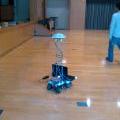Research activities at Kumon Lab.
Research projects
Robot audition
Robots using microphones to perceive and understand their surrounding environment have been actively studied in the field of "Robot Audition." We tackled this technology with a robot of 2 microphones as human and animals have two ears, and our project aims to realize autonomous robot motion under auditory sensory information.
Unmanned Aerial Vehicle and Unmanned Ground Vehicle
This project is for Autonomous control system for UAV and UGV. Autonomous flight system for a Kiteplane that has a delta shape kite-like main wing (cooperated with Skyremote Inc.), and multi rotor helicopters have been developed. UGV in outdoor environment is also studied for field robotics applications.
Robot control
Based on control theory for robot systems, this project aims to reveal a novel techniques for robot mechanical systems such as robot manipulators. Motion timing control for path following tasks has been proposed.
Publication
A list of research articles, proceedings and related documents.
Robot Audition
Robot and audition
Perception of sound, or audition, for robots is significantly important to communicate with human. In our lab, a fundamental robot action schemes for robots with auditory sensors are investigated taking dynamics of robot itself into account.
Sound source localization with robot motion
As a fundamental motion primitive for sound source localization by an auditory robot, a direct feedback of the acoustic cues to control the robot head to point the sound source is developed.
Such robot motions and changes in the environment may change the transfer characteristics of acoustic signals from the sound source to the robot, which may deteriorate the localization performance. In order to overcome this issue, it is proposed to model the effect by the change of the characteristics as the uncertainty which is taken into account by the sound localization algorithms. As another approach to reduce the effect of the uncertainty, active pinnae that was inspired from the fact some animals are able to change the shape of their pinnae to improve the sound localization performance, has been also developed.
UAV and UGV
Unmanned Aerial Vehicles and Unmanned Ground Vehicles have been extensively studied as they are expected for real practical applications. Our lab studies those robotic platform from the viewpoint of control, and autonomous behavior planning from sensory information.
UAVs such as a Kiteplane that has a delta-shape kite-like mainwing, single and multi rotor heilcopters and Vector-Thrusted ducted fan UAV have been considered. As UAV can be small and light because of its simplicty, it is sensitive to disturbances and uncertainties. Robust control system to compensate such uncertaineis is neccessary to be developed, which is one of our goals.
 Technologies to recognize the surrounding environment by UGV are studied in this project. Combination of sensors such as laser range scanner, depth cam and microphones is utilized to perceive the state of the environment.
Technologies to recognize the surrounding environment by UGV are studied in this project. Combination of sensors such as laser range scanner, depth cam and microphones is utilized to perceive the state of the environment.
Robot control
Contour Following
Welding, drawing a figure and carrying an object: those are
common application of robots in industrial use.
In order to success those tasks, it is important to
control position of an end effector, or configuration of a robot to
follow a desired path.
When a robot hand is, for instance, drawing a circle on a board,
what is important is drawing the circle precisely, not carrying
out the task punctually.
Taking this into account, the desired trajectory is defined as a function
of a parameter that has a dynamics, instead of a function of
time. The method is named as "dynamic parametrization".
By using this dynamic desired trajectory, the control method which makes the manipulator follow the desired path has been proposed.
Following applications of the method have been studied:
- manipulator
- Two-armed manipulator systems
- Adaptive approach with parametric uncertainty in the dynamics
- Biped robot control taking torque imitation into account
- Manipulators with repetitive impulsive forces
- Redundant manipulators